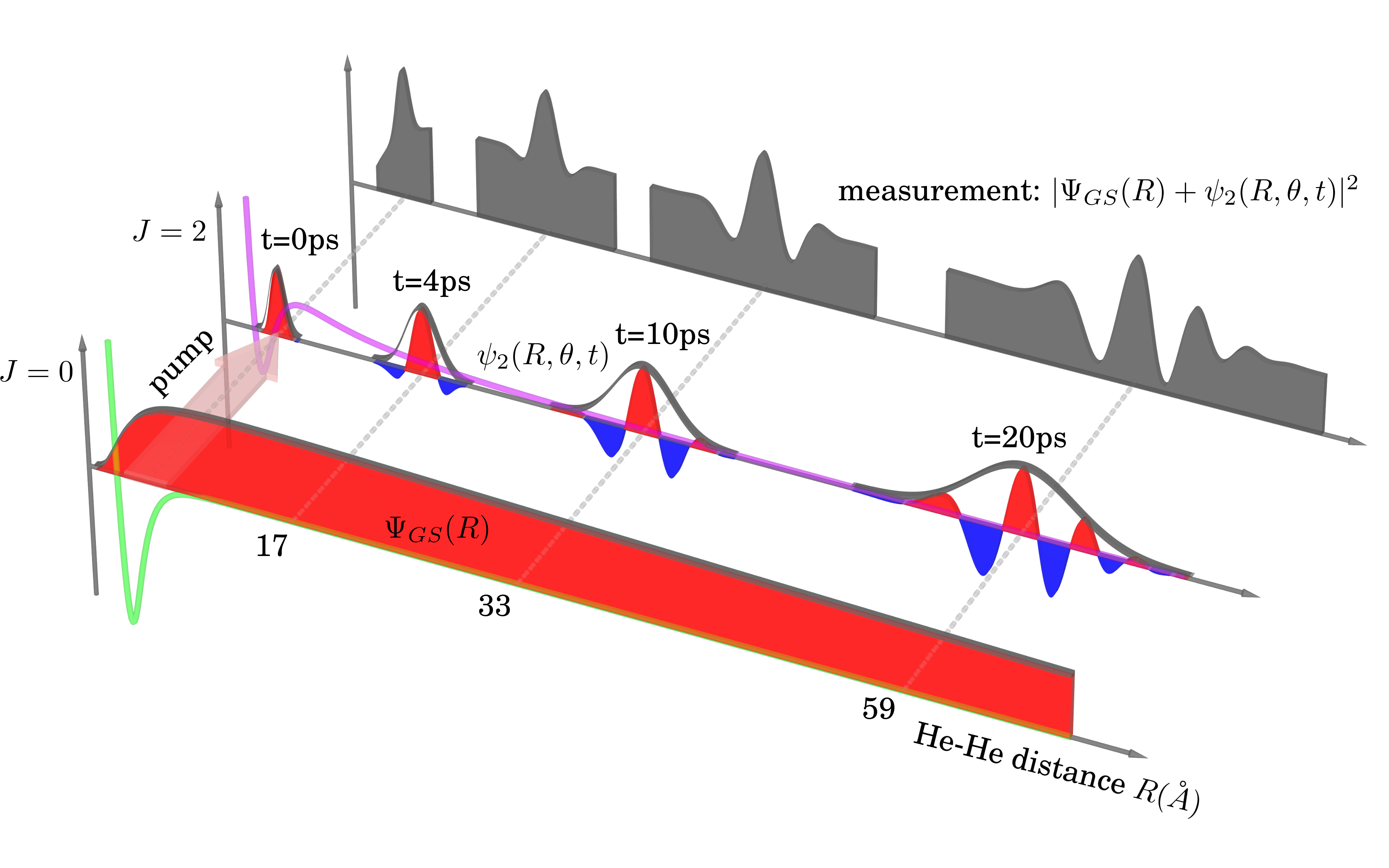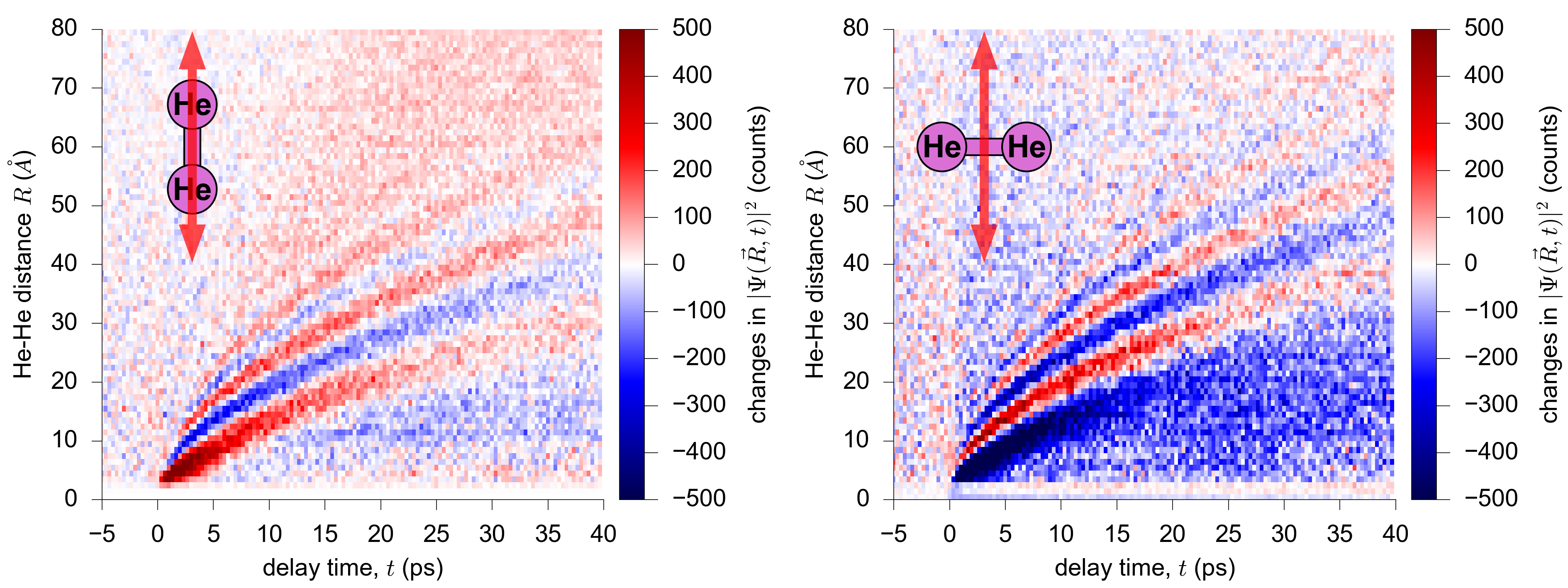Ultrafast manipulation of the weakly bound helium dimer
|
The helium dimer, 4He2, consists of two helium atoms, which are held together by an extremely weak van-der-Waals interaction. The corresponding potential is isotropic with a well depth of 11 K (0.95 meV) at an internuclear distance of 2.97 Å (Fig. 1a). In the absence of external electric fields, the potential supports a single rovibrational bound state with a binding energy of only 1.7 mK (150 neV). The state's probability distribution is isotropic and due to the tiny binding energy spreads far beyond the potential well [ref. "Imaging the He2 quantum halo state using a free electron laser"], so that about 80% of the dimer resides in the classically forbidden tunneling region, justifying the name "quantum halo". An expectation value of the interatomic distance of the helium dimer is found to be about 47 Å.
Figure 1. Field-induced interatomic potential of He2. a, Native isotropic He-He potential. b, Laser-dressed potential for an intensity of 1.3×1014 W/cm2 (E≈3.13×108 V/cm); the field polarization is shown by the orange arrow. θ is the angle between the helium dimer axis and the pump polarization direction.
We apply a short laser pulse to the helium dimer and watch its response using Coulomb explosion imaging triggered with the second delayed laser pulse. The pump laser field locally tunes the interaction between two helium atoms resulting in an effective anisotropic potential shown in Fig. 1b. Such ultrafast interaction manipulation imparts an angular momentum of 2ℏ to the dimer and evokes an initially confined dissociative wave packet on the unbound J = 2 potential (Fig. 2). We record a movie of the density and phase of this wave packet as it propagates from small to large internuclear distances (Fig. 3 and Movie 1). At large internuclear distances, where the interaction between atoms is negligible, the wave packet is essentially free. This work paves the way for future tomography of wave packet dynamics and provides the technique for studying exotic and otherwise hardly accessible quantum systems such as halo and Efimov states.
Figure 2. Schematic of radial response of the highly delocalized single state helium dimer to a strong laser field (pump). At t = 0 ps the pump field transfers a tiny part of the ground state wave function ΨGS(R) at small internuclear distances to the dissociative J = 2 potential. The evolution of this dissociative wave packet consisting mainly of the partial wave ψ2(R,θ,t) is imaged by Coulomb explosion imaging. The phase of the wave packet is resolved due to its interference with the spatially extended J = 0 ground state wave function ΨGS(R). Red and blue colors correspond to the positive and negative values, respectively, of the real part of ΨGS(R) and ψ2(R,θ,t). The radial part of the partial wave ψ2(R,θ,t) shown here is characterized by the determined group velocity of about 2.6 Å/ps but is, for illustrative purposes, less dispersive than the true wave packet.
Figure 3. Time evolution of the dissociative wave packet in He2 after the laser “kick”. a, b, Experimentally determined change of probability 2πR2(|Ψobs (R,t)|2 - |ΨGS(R)|2) (color coded) as functions of the internuclear distance and the delay time for the cases where the dimer axis is (a) parallel to the pump polarization (to make the plot, we consider θ = 0 ± 40∘) and (b) perpendicular to the pump polarization (to make the plot, we consider θ = 90 ± 40∘).
Movie 1. The movie shows the field-induced temporal evolution of the change of the probability density |Ψobs(R,t)|2 - |ΨGS(R)|2 (color coded) of He2 as a (R∥; R⊥) projection in cylindrical coordinates. R∥ and R⊥ are the parallel and perpendicular components of the internuclear distance vector R with respect to the laser field polarization. Left panel: original experimental data. Right panel: the same as on the left but after applying a low-pass filter in the Fourier space.
Publication: Ultrafast manipulation of the weakly bound helium dimer Maksim Kunitski, Qingze Guan, Holger Maschkiwitz, Jörg Hahnenbruch, Sebastian Eckart, Stefan Zeller, Anton Kalinin, Markus Schöffler, Lothar Ph. H. Schmidt, Till Jahnke, Dörte Blume, Reinhard Dörner DOI: 10.1038/s41567-020-01081-3 Nat. Phys. 17, p. 174–178 (2021) Download author's version here Show full text online here See online: DOI: 10.1038/s41567-020-01119-6 Goethe University Frankfurt (german press release) EurekAlert! webpage pro-physik.de (german press release) |



